
Being a fitness and nutritional professional, I am a huge proponent of following science and research and doing what makes the most sense. I am not afraid to admit whenever something I have advocated for or against has been proven wrong. Thus, I will always try to stay as up-to-date as possible with all of my current philosophies and recommendations, and I welcome any cordial discourse.
My Training Method: The National Academy of Sports Medicine (NASM): Optimum Performance Training (OPT) Model
The template, models, and descriptions were created and developed by the National Academy of Sports medicine.

Optimum Performance Training
Backed by multiple peer-reviewed research, NASM’s OPT model incorporates flexibility, cardio respiratory, core, balance, reactive, speed, agility, quickness, and strength into every program. This improves all biomotor abilities and builds high levels of functional strength, neuromuscular efficiency, and dynamic flexibility.
- Stabilization Endurance Training phase is crucial for all individuals no matter their goals as it prepares them for the higher demands of training, it will also be important to cycle back through this phase of training between periods of higher intensity training, allowing for proper recovery and maintenance of high levels of stability that will ensure optimal strength and/or power adaptations. This phase of training focuses on:
- Increasing Stability
- Muscular Endurance
- Improving Flexibility
- Increasing Neuromuscular Efficiency of the Core Musculature
- Improving Inter-muscular and Intramuscular Coordination
The primary focus when progressing in this phase is on increasing the proprioception (controlled instability) of the exercises, rather than just the load.
- Strength Endurance Training is a hybrid form of training that promotes increased stabilization endurance, hypertrophy, and strength. This form of training entails the use of superset techniques where a more stable exercise (such as a bench press) is immediately followed with a stabilization exercise with similar biomechanical motions (such as a standing cable chest press). Therefore, for every set of an exercise/body part performed according to the acute variables, there are actually two exercises or two sets being performed. High amounts of volume can be generated in this phase of training.
- Optional* – Hypertrophy Training is specific for the adaptation of maximal muscle growth, focusing on high levels of volume with minimal rest periods to force cellular changes that result in an overall increase in muscle.
- Optional* – Maximal Strength Training focuses on increasing the load placed upon the tissues of the body. Maximal intensity improves:
- Recruitment of More Motor Units
- Rate of Force Production
- Motor Unit Synchronization
Maximal Strength Training has also been shown to help increase the benefits of forms of power training used in Phase 5.
- Optional* – Power Training focuses on both high force and velocity to increase power. This is accomplished by super-setting a strength exercise with power exercise for each body part (such as performing a barbell bench press super-set with a medicine ball chest pass).
Whether stabilization, strength, endurance, power, fat loss, hypertrophy, flexibility, or more energy, workouts will indeed vary depending on one’s individual goals. Thus, I will try to post and share a variety of workouts for a variety of goals.
Message me for post suggestions! 🙂